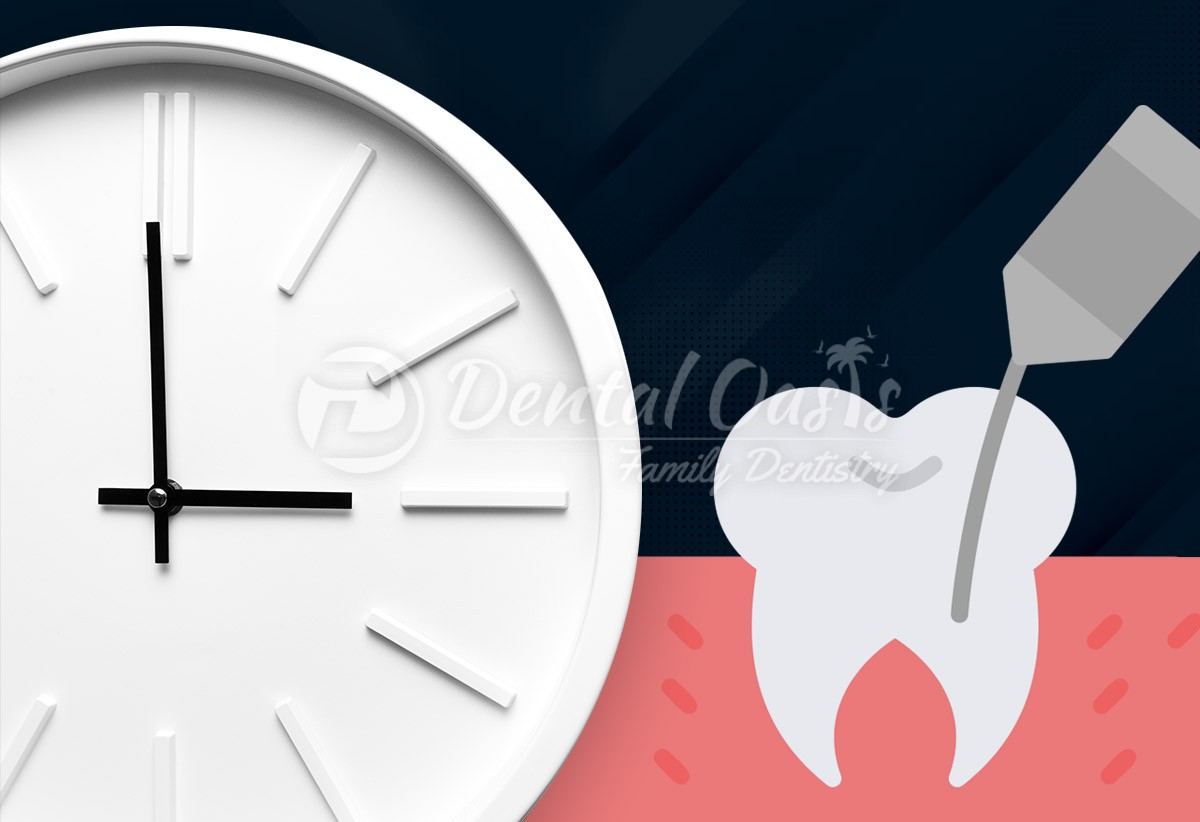Root Canal Recovery Time: What to Expect in Initial Days & Tips for Fast Recovery

Recovering from a root canal is easier than recovering from a tooth extraction. Although the same anesthetic injection is given in both procedures to achieve numbness, the recovery time may differ. Patients’ root canal recovery time faster if they know what the dos and don’ts after a root canal treatment are. This article will provide patients with all of the information they need to recover faster from a root canal. Continue reading to know more.
You can also read our full guide on baby root canal, where we cover its procedure, dangers, recovery, and cost.
Root Canal Recovery Time
Usually, the recovery time of a root canal is three to seven days. Patients can go back to work the same day after their numbness from the anesthesia wears off. It takes four hours for the numbness to go away. However, if a patient is not feeling comfortable, it is advised to take the day off and go back to work the next day. The painkillers and anti-inflammatory medicines prescribed by the dentist work very well to relieve the discomfort that occurs in the first one to two days. But each tooth is different, and so is the case. Hence, recovery from a root canal also differs from person to person. There are several factors on which the recovery time depends. Let us discuss these factors first!
- Anatomy of Tooth: Sometimes complex anatomy of the tooth such as an extremely curved canal, multiple canals or calcification of the canal make a root canal procedure lengthy and can prolong the recovery time.
- Severity of Infection and Inflammation: Severe infections like an abscess or cases with a sinus formation take more time to heal.
- Not Following the Post-Operative Instructions Properly: If a patient does not follow the given instructions (verbally or written) about what to do and what not to do, this will only lead to complications and extend the recovery time.
- Root Canal Retreatment: For patients who undergo root canal retreatment, recovery time can be longer if it is associated with complications such as a detached instrument, ledges in the canal, or perforations.
However, most of the time, patients get relief from the pain after the first sitting of the root canal treatment. In rare cases, the pain might persist after the first sitting but can be manageable with painkillers.
What to Expect in the Initial Days of Root Canal?
Immediately after a root canal the tongue and the area where the root canal was done will be numb for a few hours. Therefore, it is advised not to consume food or hot fluids until the numbness subsides, as chewing with a numb mouth can lead to injury to soft tissue (including the tongue, cheeks, and lips). The tooth may feel sensitive for the first few days after a root canal is finished due to tissue inflammation, particularly if there was severe pain or infection prior to the procedure.
YOU MAY ALSO LIKE: Root Canal Misconceptions
Root Canal Recovery Tips
If a patient follows all the post-operative instructions properly, recovery from a root canal would be faster. Here are some tips to achieve a faster recovery.
- Do not chew from that side where the root canal is performed until it is restored with a crown. This is because the unrestored tooth is prone to fracture. They are brittle and the crown provides them strength to take the chewing forces. If someone who is undergoing root canal treatment starts chewing from the root canal-treated teeth, the tooth will fracture and will result in root canal failure.
- Eat soft meals that require little chewing after a root canal, such as applesauce, yogurt, and eggs. Foods that could damage the teeth, such as hard or hot meals, should be avoided. Crunchy, hard and chewy food like popcorn, nuts, hard candies, chips, etc. should be absolutely avoided. Avoid sticky foods as well as taking off the temporary filling that has been put to seal the root canal-treated tooth.
- Brushing after a root canal should be gentle in the operated area. But it doesn’t mean one should not properly take care of oral hygiene. Be gentle with the brushing strokes and brush twice a day. Flossing should also be done with utmost care.
- Take adequate rest to recover faster. Sleeping and taking painkillers will help in recovery.
- Sleeping with an extra pillow would help to minimize swelling.
- For those who want a speedy recovery after their root canals, smoking is a big no. Smoking can result in further complications and increases the likelihood of requiring another procedure. Smoking interferes with the healing process and thus results in complications in root canal recovery. According to a study from 2020, tobacco users have a higher likelihood of needing a root canal. In prior research, it was discovered that smokers had a 1.7-fold higher risk of needing a root canal than nonsmokers. Those who gave up smoking cigarettes saw a decrease in this percentage.
- Do not do any strenuous activities or heavy exercises during the healing phase. This is because heavy exercise or physical activity can increase the likelihood of flare-ups or the occurrence of severe toothache.
- An ice pack applied to the affected area can be extremely helpful. It can significantly lessen the swelling and discomfort individuals experience after getting a root canal.
- Most importantly, watch out for recovery symptoms. If the tooth does not hurt after two to three days and after a few days of healing the discomfort and swelling start to decrease, this indicates signs of a good recovery. However, if pain, swelling, and discomfort don’t get better even after two or three days or it worsens or an allergic rash appears or the temporary filling comes out, the dentist should be contacted immediately. These conditions can be easily managed if treated at the right time.
- Lastly, do not miss the follow-up visit with the dentist even if the tooth is not hurting anymore.
Conclusion
To conclude, following the dentist’s instructions is crucial to achieving a good and speedy recovery. Most root canals complications, like a fracture of the tooth or a flare-up, occur if the post-operative instructions are not followed. Be careful to take care of the tooth until it receives a permanent crown. Always remember, that a root canal treatment of posterior teeth is incomplete without a crown. A root canal-treated tooth that has been properly cared for and restored can last as long as the natural teeth.
If you are feeling some discomfort in your teeth and planning to undergo root canal treatment, then contact Dr. Sharda Patel. She is a Pleasanton-based dentist who provides root canal treatment, general dentistry, and cosmetic dentistry service. Schedule a dental appointment now or call us at 925-846-4491







